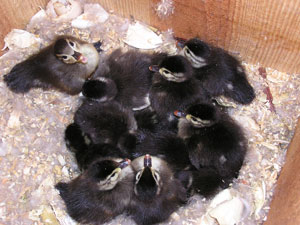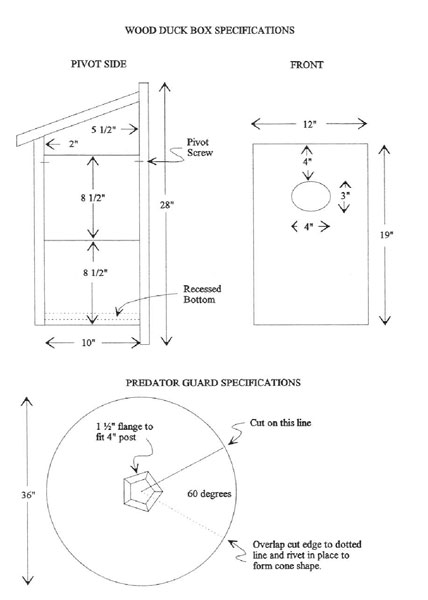Wood Duck Box Construction
 The wood duck (Aix sponsa) often is referred to as the "Summer Duck" in South Carolina. As a resident, it is one of only a few of the waterfowl reproducing in the Palmetto State. Wood ducks are cavity nesters preferring natural cavities or "hollows" in older trees more common in mature bottomland forested wetlands.
The wood duck (Aix sponsa) often is referred to as the "Summer Duck" in South Carolina. As a resident, it is one of only a few of the waterfowl reproducing in the Palmetto State. Wood ducks are cavity nesters preferring natural cavities or "hollows" in older trees more common in mature bottomland forested wetlands.
Wood ducks readily adapt to man-made nest boxes where natural cavities may be limited or lacking. Construction of nest boxes and erection of nest box units can be an enjoyable and rewarding experience for anyone interested in a hands-on waterfowl conservation project.
Do not build or erect a wood duck nest box unless it will be protected from predators and placed in or adjacent to a suitable permanent water site. Poorly erected and seldom maintained nest boxes do little to benefit production. The predator shield is the most important factor in erecting a box. This all important conical guard placed below the nest box will protect from climbing raccoons, rat snakes and other predators. When preparing a site for a box trim low, overhanging limbs or nearby small trees within 48" of the nest box to prevent the overhead approach of predators. The maintenance of vegetation around and above the box is an annual part of proper box maintenance.
It is best to erect nest boxes in the shallow, permanent water of a marsh or pond having a good mix of open water and emergent plant cover. Although it is good to have boxes in open water, boxes should not be placed in areas which will prevent maintenance. A box in 4"-8" of water in a forested wetland that can be readily checked and maintained will be much more productive than a box in open water that is never visited. An adequate amount of interspersed wetland vegetation will provide both escape cover and habitat where ducklings will be able to forage for aquatic insects necessary for growth and development. Mount nest boxes on poles having a height of at least 48" above highest seasonal water levels.
Space nest box units such that it will be difficult to see one nest box from another either using distance or concealing vegetation. Never mount 2 nest boxes back-to- back in a "piggy-back" fashion. This practice encourages intraspecific competition for nest boxes and leads to dump nesting. Dump nesting, a product of density strife, is the result of more than 1 hen using a single box and laying at least 18 and up to 50 or more eggs. Dump nesting drastically lowers potential productivity. Remember, the wood duck is not a colonial nesting species, wood ducks evolved as solitary nesters in forested wetlands where natural cavities were widely dispersed. Nest box projects, therefore, should mimic nature.
 Start with a few boxes initially and increase as local populations grow remembering not to over-saturate. It may take several years before the first box is used, or it may be used immediately. The best time to erect nest boxes is prior to the start of the nesting season which can vary between December and March. Nest boxes should be erected on wooden or metal poles. Poles can be driven with a sledge hammer into soft, muck soil in most marshes or ponds. Posthole diggers work well, even underwater, in hard or clay soil. Be certain each post is securely set so it will bear the nest box and jostling by an individual checking the boxes. Wood ducks do not carry any nesting material into the nest. Place 3"- 8" of wood shavings in the box to insulate nests when cleaning out boxes prior to the start of nesting season. This will provide adequate material for the entire season even as material is removed during monitoring following successful or destroyed clutches.
Start with a few boxes initially and increase as local populations grow remembering not to over-saturate. It may take several years before the first box is used, or it may be used immediately. The best time to erect nest boxes is prior to the start of the nesting season which can vary between December and March. Nest boxes should be erected on wooden or metal poles. Poles can be driven with a sledge hammer into soft, muck soil in most marshes or ponds. Posthole diggers work well, even underwater, in hard or clay soil. Be certain each post is securely set so it will bear the nest box and jostling by an individual checking the boxes. Wood ducks do not carry any nesting material into the nest. Place 3"- 8" of wood shavings in the box to insulate nests when cleaning out boxes prior to the start of nesting season. This will provide adequate material for the entire season even as material is removed during monitoring following successful or destroyed clutches.
Rough sawn, cypress, pine or cedar lumbers are good choices as a nest box building material. If smooth or dressed lumber is used, be sure to tack a piece of mesh screening to the inside under the entrance hole. This will enable day-old ducklings to climb up and exit with the brood when the hen calls from the water below. All nest boxes should be checked each winter prior to the nesting season to replace nesting material, check the tightness of the predator guard and secure the lid and screen door latch. Production inspections should be made as often as possible during March through June, but at least once in April or May.
Specifications for Wood Duck Box Construction
Materials
- Rough cut cedar, yellow pine or cypress boards 1" thick are preferred, but exterior plywood is an acceptable substitute. DO NOT use treated lumber.
- Weather resistant latch on the side flap that opens for maintenance (ex. 2" zinc hook & eye)
- Zinc coated 1 1/2" inch wood screws
Sides (10" wide)
- One side with pivoting flap
- Flap beveled for opening 8 1/2" above the bottom
- Flap beveled at top
- Pivot screws 16" above the bottom
- Use countersunk wood screws
Bottom
- Recessed at least 1/4" with five holes at least 3/8" diameter for drainage
Top (12" wide)
- Overhang front by 1½"
- Use countersunk wood screws
- Bevel back cut to match back board
Front (12" wide)
- Opening cut 4" diameter circle (allows for use by WODU & BBWD)
- Opening 4" from top of front board
- Use countersunk wood screws
- Bevel top cut to match top board
Back (12" wide)
- Leave 2" above and below for mounting to post with lag bolts
- Use countersunk wood screws
Predator Guard
- Use 26-29 gauge aluminum flashing or galvanized metal, 36" wide
- See figure for specifications on inverted cone design
Post
- Pressure treated 4" by 4" wooden post, various lengths depending on water depth
Guidelines for Mounting Wood Duck Nest Boxes
- Boxes should not be hidden. Boxes should be placed so that there is a 40'' flight line in front of the box that is free from obstructions such as tree limbs or bushes.
- Using a 4"x4"x10' treated wooden post, the post should be buried deep enough (24-36") to support the weight of the box and secure enough to support monitoring activities. If using lag bolts, drill a hole for the lag bolts used to mount the box. Install the post into the ground.
- Slip the predator guard over the post, but do not nail to post. Mount the box onto the post; then nail the predator guard in place, just below the box.
- When attaching the box to the post, use 2, 3"- 5" lag bolts or 4, 2"- 3" deck screws instead of nails. Bolts and screws make it easier to remove boxes in the future for replacement or repair as necessary.
- Attach a 2" hook and eye to the base of the door to ensure box remains shut
- Position the box as nearly vertical as possible, with a very slight tilt forward. The tilt will enable ducklings to climb out more easily. Add wood shavings to a depth of 4"- 8" in the bottom of the box.
- Boxes should be placed at the rate of 1 per acre in suitable brood-rearing habitat.
- Boxes should be placed so that the bottom of the box is at least 4 feet above the high water mark.
- Do not place more than one box per post, as this may increase the possibility of "dump nesting."
- No box should be mounted without a predator guard or without the intention of maintenance and monitoring.
- If multiple boxes are used on a property, livestock ear tags can be purchased from many farm supply stores and used to number the boxes.
Contact
Wildlife and Freshwater Fisheries Division
Phone: 803-734-3886
You can download and print the information on the Construction of Wood Duck Boxes which is in the Adobe PDF file format.
